Kurukshetra Summary: May, 2024 – Towards Embracing Green Technology
1. Green Technologies: Current Status, Challenges, and Way Ahead
- 1. Green Technologies: Current Status, Challenges, and Way Ahead
- 2. Understanding Green Technologies for Future
- Introduction
- Types of Green Technology
- Cleantech vs. Greentech
- Environmental Benefits of Green Technology
- Economic Implications of Green Technology
- Social Impact and Equity Considerations
- Key Areas of Green Technology Adoption
- Challenges and Barriers to Adoption of Green Technology
- Policy Frameworks and Strategies for Promoting Green Technology
- The Role of International Collaboration and Cooperation
- 3. Green Technologies for Clean and Renewable Energy
- 4. Empowering Rural Communities: Embracing Green Waste Tech in India
- Introduction
- Current State of Waste Management in Rural Regions
- Analysis of the Impact of Green Waste Technologies on Rural Communities
- Identification of Barriers to Adoption of Green Technologies in Rural Regions
- Potential Solutions and Innovations
- Strategies for Overcoming Barriers to Adoption and Scaling up Green Technologies
- Case Studies
- Policy Recommendations and Conclusion
- 5. Biodiversity Conservation using Remote Sensing and GIS Tools
- 6. Usage of Green Technology in Sustainable Water Management
- 7. Green Technologies for Sustainable Agriculture
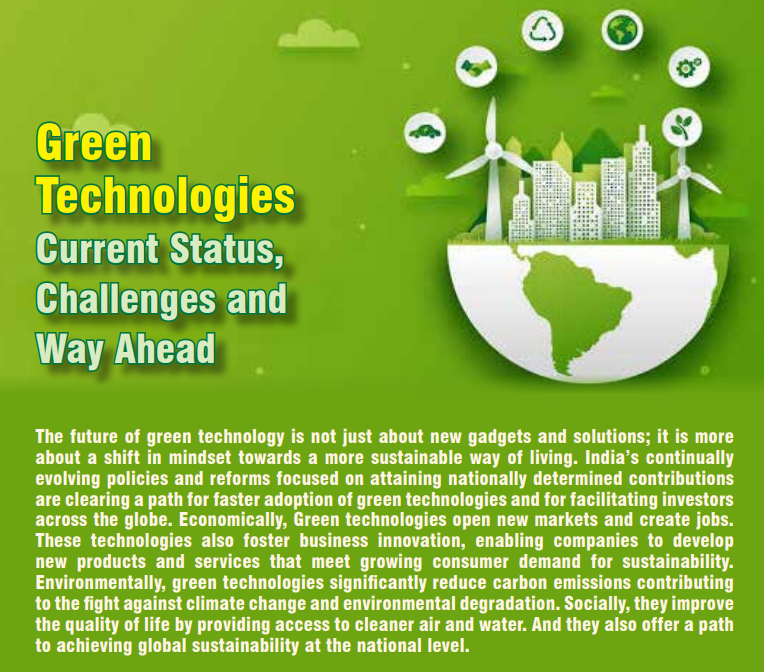
Introduction
- Green technology is pivotal in fostering a sustainable future. It encompasses innovations aimed at environmental enhancement and resource efficiency, crucial for addressing climate change and resource scarcity.
- India’s evolving policies and reforms aim to accelerate the adoption of green technologies, promoting sustainability and economic growth.
Current Status
Energy Sector:
- India is progressively adopting renewable energy sources such as solar, wind, and bioenergy.
- Notable initiatives like the National Solar Mission and the National Green Hydrogen Mission are leading this transition.
- These efforts are aimed at reducing dependency on fossil fuels and decreasing carbon emissions.
Building Sector:
- The implementation of green building designs is gaining momentum.
- Focus is placed on energy efficiency and the use of sustainable materials in construction.
- Such measures are intended to reduce the environmental impact of buildings throughout their lifecycle.
Transport Sector:
- There is significant growth in the adoption of electric vehicles and the development of sustainable public transit systems.
- This transition is critical for reducing pollution and promoting cleaner urban environments.
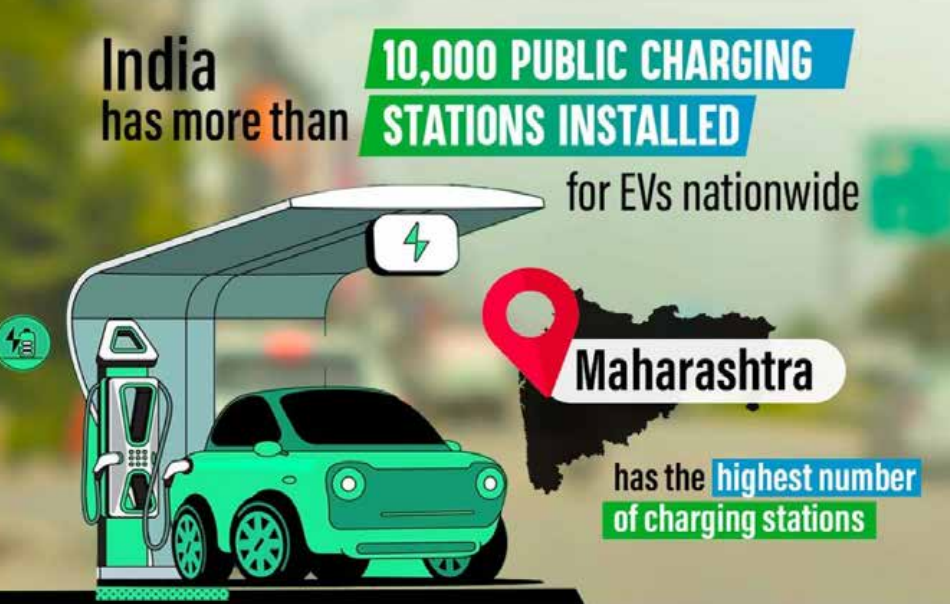
Water and Waste Management:
- Advanced waste management technologies are being introduced to improve recycling and waste disposal processes.
- Sustainable water usage practices are also being promoted to address water scarcity and ensure efficient water resource management.
Challenges
High Initial Investment:
- The adoption of green technology requires significant capital investment, which can be a barrier for many organizations and individuals.
- Ensuring adequate funding and financial support is essential for widespread adoption.
Regulatory Hurdles:
- Complex regulations and bureaucratic processes can impede the development and implementation of green technologies.
- Streamlining regulatory frameworks is necessary to facilitate progress.
Public Acceptance:
- Greater public awareness and acceptance of green technologies are needed.
- Educating the public on the benefits of these technologies is crucial for their success.
Infrastructure:
- Existing systems and infrastructures need to be adapted or upgraded to support new green technologies.
- This transition can be challenging and requires careful planning and investment.
Resource Management:
- Efficient use and management of renewable resources are vital to ensure their sustainability.
- Implementing effective resource management practices is critical for long-term success.
Significance
Economic Growth:
- Green technology creates new markets and job opportunities, driving economic growth.
- Investments in green technology can lead to a more resilient and sustainable economy.
Environmental Benefits:
- The adoption of green technologies results in a reduction of carbon emissions and environmental degradation.
- These technologies contribute to the preservation of natural ecosystems and biodiversity.
Social Impact:
- Green technology can improve the quality of life by providing access to cleaner air and water.
- It also promotes healthier living environments and communities.
Innovation:
- The push for green technology encourages business innovation and the development of sustainable products.
- This drive for innovation can lead to breakthroughs that further enhance sustainability efforts.
Solutions
Policy Support:
- Government incentives and supportive policies are crucial for the adoption and development of green technologies.
- Policy measures should include subsidies, tax incentives, and regulatory support to encourage investment.
Public Awareness:
- Campaigns to increase public knowledge and acceptance of green technologies are essential.
- Educating the public about the benefits and importance of these technologies can drive adoption and support.
Investment in Research and Development:
- Funding for research and development is necessary to advance green technologies.
- Continuous innovation and improvement are needed to make these technologies more efficient and affordable.
Infrastructure Development:
- Building and adapting infrastructure to support green technologies is a priority.
- Investments in modern infrastructure are necessary to facilitate the transition to a sustainable future.
International Collaboration:
- Partnering with global entities to share knowledge and resources is beneficial.
- International collaboration can accelerate the development and deployment of green technologies.
Conclusion
- Green technology is essential for a sustainable future, addressing economic, environmental, and social challenges.
- India’s commitment to green technology through policies and initiatives sets a path for global leadership in sustainability.
- The way forward involves overcoming challenges through strategic investments, supportive policies, and public engagement.
- As aptly stated, “The future will either be green or not at all.” This emphasises the crucial role of green technology in shaping a sustainable future for all.
2. Understanding Green Technologies for Future
Introduction
- Green technologies, also known as sustainable or clean technologies, aim to address environmental challenges and promote sustainability.
- These technologies minimize negative environmental impacts, conserve natural resources, and reduce greenhouse gas emissions.
- Green technology spans various scientific research areas, including energy, atmospheric science, agriculture, material science, and hydrology.
- The primary goals are to protect the environment, repair past environmental damage, and conserve Earth’s natural resources.
Types of Green Technology
- Green technology can be broadly categorized into four main areas: renewable energy sources, sustainable transportation, waste management and recycling, and energy efficiency solutions.
- Each category plays a crucial role in minimizing environmental impact and ensuring a greener future.
Cleantech vs. Greentech
- Cleantech focuses on improving the environmental performance of existing technologies.
- Greentech promotes the adoption of new, sustainable solutions and encourages the use of renewable resources.
Environmental Benefits of Green Technology
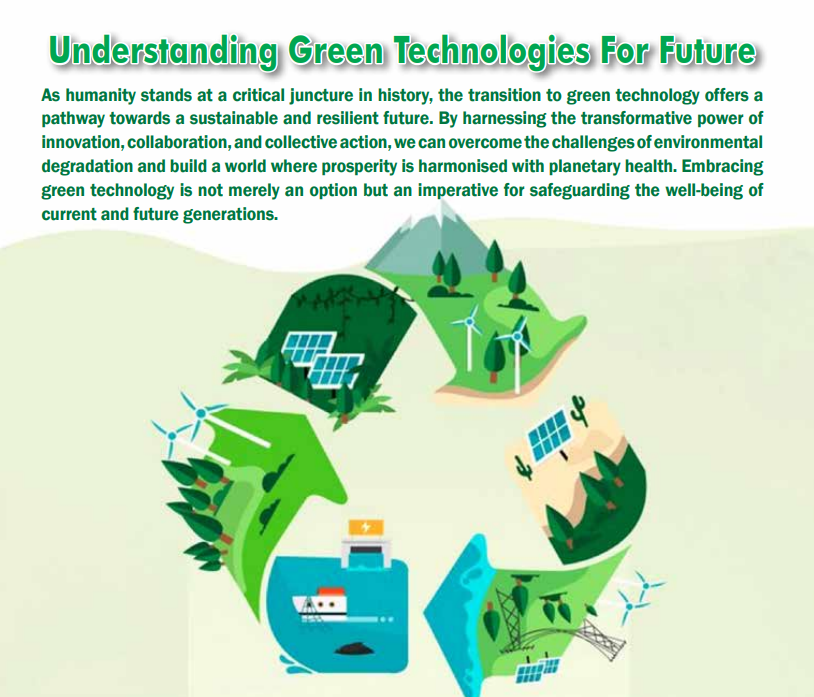
- Reduced Carbon Emissions: Green technologies often utilize renewable energy sources such as solar, wind, hydro, and geothermal power. These sources significantly reduce emissions, helping to mitigate climate change.
- Energy Efficiency: Technologies like energy-efficient appliances, LED lighting, smart thermostats, and building insulation reduce energy consumption, thus lowering fossil fuel combustion and emissions.
- Water Conservation: Technologies that reduce water usage help conserve freshwater resources, particularly in regions facing water scarcity.
- Waste Reduction and Recycling: Advanced recycling technologies and processes minimise waste by recovering valuable materials from discarded products.
- Improved Air Quality: Technologies that replace fossil fuel combustion with cleaner alternatives, such as electric vehicles, improve air quality by reducing pollutants like nitrogen oxides, sulphur dioxide, and particulate matter.
- Long-Term Sustainability: These technologies reduce reliance on finite resources and minimise environmental degradation, ensuring that future generations can meet their needs without compromising the ability of future generations to meet theirs.
Economic Implications of Green Technology

- Job Creation: Sectors like renewable energy, energy efficiency, and sustainable transportation stimulate employment growth, offering opportunities for skilled workers and boosting local economies.
- Market Growth and Innovation: The shift towards green technology drives innovation and market growth as businesses invest in research and development of cleaner and more sustainable products and services.
- Cost Savings: While initial investments in green technology may be higher, they often result in long-term cost savings.
- Resource Efficiency: Green technologies promote resource efficiency by minimising waste and maximising the use of renewable resources.
- Energy Independence: Investing in domestic renewable energy sources enhances energy security and reduces dependence on imported fossil fuels, stabilising energy prices and reducing exposure to geopolitical risks.
- Financial Incentives and Subsidies: Governments often provide financial incentives, subsidies, tax credits, and grants to encourage the adoption of green technologies. These policies stimulate private sector investment, drive innovation, and accelerate market adoption, ultimately boosting economic growth and competitiveness.
- Resilience to Climate Change: Investing in green technology and infrastructure enhances resilience to climate change impacts, such as extreme weather events and sea-level rise.
Social Impact and Equity Considerations
- Environmental Justice: Green technology addresses environmental injustices by reducing pollution and mitigating the impacts of climate change, which disproportionately affect low-income and marginalized communities.
- Job Creation and Training: Training programs and workforce development initiatives create pathways to employment in the green economy, offering opportunities for economic advancement and social mobility for marginalised populations.
- Community Resilience and Adaptation: Investing in green infrastructure enhances community resilience to climate change impacts, protecting vulnerable populations and reducing disparities in exposure to environmental risks.
- Public Transportation and Mobility Equity: Sustainable transportation options promote mobility and accessibility for underserved communities, reducing transportation costs and improving air quality while ensuring that everyone can access essential services and opportunities.
- Digital Divide and Access to Technology: Bridging the digital divide is essential for ensuring that all communities can fully participate in the green economy and benefit from technological advancements, promoting equity and inclusion in the digital age.
Key Areas of Green Technology Adoption
- Renewable Energy: This includes solar, wind, hydroelectric, geothermal, and biomass energy technologies. Renewable energy sources offer alternatives to fossil fuels, reducing greenhouse gas emissions and dependence on finite resources.
- Energy Efficiency: Green technology focuses on improving energy efficiency across industries, buildings, appliances, and transportation. This includes advancements in insulation, LED lighting, smart thermostats, and energy-efficient appliances to reduce energy consumption.
- Green Building: Green building technologies promote sustainable design, construction, and operation of buildings. This involves incorporating energy-efficient materials, passive design strategies, green roofs, and efficient HVAC systems to minimise environmental impact and enhance occupant comfort.
- Sustainable Transportation: This area includes electric vehicles, hybrid vehicles, public transit systems, cycling infrastructure, and alternative fuels. Sustainable transportation options aim to reduce greenhouse gas emissions, air pollution, and reliance on fossil fuels.
- Waste Management and Recycling: Green technology innovations focus on waste reduction, recycling, and waste-to-energy conversion. Advanced recycling processes, composting systems, and waste-to-energy facilities help minimise landfill waste and recover valuable resources.
- Water Conservation and Treatment: Technologies for water conservation, purification, and reuse play a crucial role in sustainable water management. This includes low-flow fixtures, rainwater harvesting systems, wastewater treatment technologies, and desalination.
- Agroecology and Sustainable Agriculture: Green technology promotes sustainable agricultural practices that minimise environmental impact and enhance productivity. This includes organic farming, precision agriculture, agroforestry, and soil conservation techniques.
- Environmental Monitoring and Management: Technologies for environmental monitoring, data analytics, and modelling help assess environmental quality, track pollution levels, and inform decision-making for resource management and conservation.
- Circular Economy and Sustainable Materials: Green technology advances circular economy principles by promoting resource efficiency, recycling, and the use of sustainable materials. This includes innovations in eco-friendly materials, product design for disassembly and recycling, and closed-loop manufacturing processes.
Challenges and Barriers to Adoption of Green Technology
- High Initial Costs: Many green technologies, such as renewable energy systems and energy-efficient appliances, often have higher upfront costs compared to conventional alternatives, which can be a significant barrier for individuals, businesses, and governments.
- Limited Access to Capital: Access to financing and capital for green technology projects can be challenging, especially for small businesses and individuals. Banks and financial institutions may be hesitant to provide loans for innovative or perceived high-risk projects, hindering adoption.
- Technological Barriers: Some green technologies may still be in the early stages of development or face technological limitations, such as intermittent energy production for renewables or energy storage capacity for electric vehicles.
- Regulatory and Policy Constraints: Inadequate or inconsistent regulations, permitting processes, and zoning restrictions can hinder the deployment of green technologies. Uncertainty about regulatory requirements and compliance can deter investment and innovation.
- Lack of Public Awareness and Education: Limited awareness and understanding of green technologies among the general public, businesses, and policymakers can hinder adoption.
- Infrastructure Limitations: Inadequate infrastructure, such as charging stations for electric vehicles or grid interconnections for renewable energy systems, can limit the scalability and adoption of green technologies.
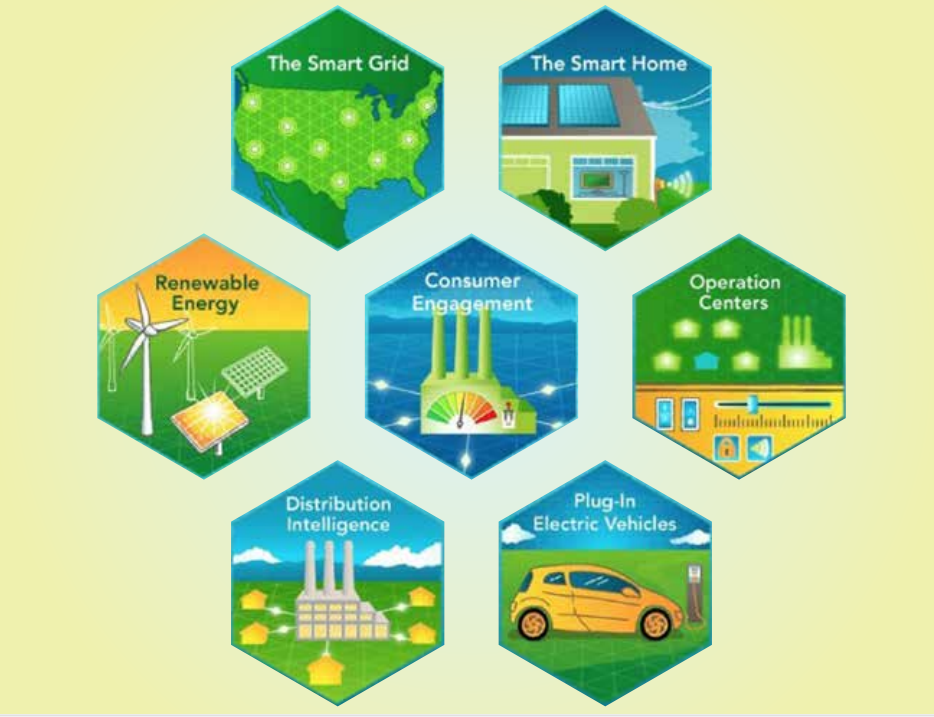

Policy Frameworks and Strategies for Promoting Green Technology
- Financial Incentives: Financial incentives such as tax credits, grants, subsidies, and low-interest loans to support green technology adoption can help offset the higher upfront costs and encourage investment in renewable energy, energy efficiency, sustainable transportation, and other green initiatives.
- Regulatory Measures: This may include setting renewable energy targets, energy efficiency standards for buildings and appliances, emissions reduction requirements for vehicles, and renewable portfolio standards for utilities.
- Research and Development Funding: Investing in research and development can drive technological advancements, reduce costs, and improve the performance and scalability of green solutions.
- Public Procurement Policies: Using government procurement policies to prioritise the purchase of green products and services can create market demand for sustainable goods and services, driving innovation and lowering costs through economies of scale.
- Education and Outreach Programs: Developing educational campaigns and outreach programs to raise awareness about the benefits of green technology and provide training and technical assistance to businesses, communities, and individuals.
- Partnerships and Collaboration: Fostering partnerships and collaboration among governments, businesses, academia, and civil society to promote green technology innovation, deployment, and diffusion.
- Capacity Building and Technical Assistance: Providing capacity-building support and technical assistance to help businesses, communities, and governments navigate the challenges of adopting and implementing green technologies. This may include training programs, feasibility studies, and knowledge-sharing platforms.
- Integrated Planning and Policy Coherence: Ensuring coherence and alignment across policies, plans, and sectors to create an enabling environment for green technology adoption. Integrated planning approaches can address cross-cutting issues and promote synergies between economic, environmental, and social objectives.
- International Cooperation and Knowledge Sharing: Engaging in international cooperation and knowledge sharing to exchange best practices, experiences, and lessons learned in promoting green technology can facilitate technology transfer, capacity building, and collective action on climate change and sustainability.
The Role of International Collaboration and Cooperation
- International collaboration and cooperation play a pivotal role in advancing green technology and addressing global environmental challenges.
- Knowledge Sharing and Research: Collaborating across borders allows scientists, researchers, and experts to share knowledge, data, and best practices. International research partnerships accelerate innovation, leading to breakthroughs in green technology.
- Joint Research and Development (R&D): Countries pool resources to conduct joint R&D projects. Collaborative efforts enhance the development of clean energy sources, efficient materials, and eco-friendly processes.
- Standardisation and Harmonization: International cooperation establishes common standards for green technologies. Harmonised regulations facilitate the adoption of sustainable practices across different regions.
- Policy Alignment: International agreements, such as the Paris Agreement, promote policy alignment. Shared goals drive countries to adopt similar policies, regulations, and incentives for green technology adoption.
- Capacity Building: Developing countries benefit from capacity-building programs. Knowledge transfer, training, and technology transfer enhance their ability to adopt and implement green solutions.
3. Green Technologies for Clean and Renewable Energy

Global Electricity Demand and Renewable Energy Scenario
- According to the ‘Electricity, 2024 Report’ from the International Energy Agency, global electricity demand is expected to grow at an average rate of 3.4% from 2024 through 2026.
- Approximately 85% of this increase in demand is projected to come from India, China, and South-East Asian countries.
- Renewable and clean energy sources with low emissions comprised only 40% of global electricity generation in 2023.
- Emissions from Energy: The energy sector is the leading contributor to climate change, responsible for around 60% of total global greenhouse gas emissions.
Present Renewable Energy Scenario
- Global Capacity: The International Renewable Energy Agency reported that global renewable power capacity reached 3,870 gigawatts by the end of 2023. Solar energy had the largest share at 1,419 gigawatts.
- Emission Reductions: From 2019 to 2023, the deployment of solar photovoltaic, wind power, nuclear power, electric cars, and heat pumps avoided around 2.2 billion tonnes of emissions annually.
- Renewable hydropower and wind energy had total capacities of 1,268 gigawatts and 1,017 gigawatts, respectively. Additional capacities included 150 gigawatts of bioenergy, 15 gigawatts of geothermal, and 0.5 gigawatts of marine energy.
Renewable Energy in India
- Installed Capacity: In India, renewable energy sources, including large hydropower, had a combined installed capacity of 183.49 gigawatts, with approximately 13.5 gigawatts added in 2023.
- Dominant Sources: Solar energy dominated with 75.57 gigawatts, followed by wind energy at 44.15 gigawatts.
- Future Goals: India aims for 500 gigawatts of renewable energy installed capacity and five million tonnes of green hydrogen production by 2030. Targets also include reducing carbon intensity by less than 45% by 2030, achieving 50% cumulative electric power installed from renewables by 2030, and attaining net-zero carbon emissions by 2070.
Green Technologies for Clean Energy
- Investment Growth: Clean energy investment saw a significant increase of nearly 50% from 2019 to 2023, reaching USD 1.8 trillion in 2023. This growth is expected to continue at around 10% per year.

- Solar Energy:
- Photovoltaic (PV) cells convert sunlight directly into electricity and are the foundation of solar power generation.
- Emerging technologies like multi-junction cells, tandem cells, and perovskite-silicon hybrid cells are improving efficiency and reducing costs.
- Concentrated Solar Power (CSP) systems use mirrors or lenses to focus sunlight onto a receiver, generating heat for electricity production. Innovations in CSP, such as molten salt storage and advanced heat transfer fluids, enhance efficiency and storage capabilities.
- Wind Power:

- Wind power capacity grew by 13% in 2023, reaching a total of 1,017 gigawatts. This includes both onshore and offshore installations.
- Innovations in wind power include taller turbines with longer blades, vertical axis wind turbines, and kite wind energy systems.
- Offshore wind power is expanding significantly, with floating turbine technology tapping into stronger wind currents.
- Hydroelectric Energy:

- Hydropower remains the largest renewable source of electricity. In the Net Zero Emissions by 2050 Scenario, it maintains an average annual generation growth rate of nearly 4% from 2023 to 2030.
- Advanced turbine designs are more environmentally friendly, and kinetic hydro turbines show promise for small-scale power generation.
- Nuclear Power:
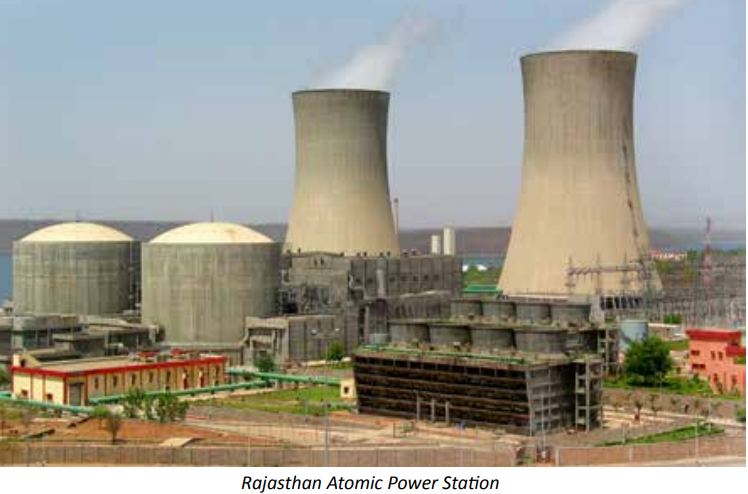
- Nuclear power is the second-largest source of low-carbon electricity, with a global capacity of approximately 413 gigawatts.
- Small modular reactors (SMRs) and micro-reactors are emerging technologies expanding global access to nuclear energy.
- Energy Storage Technologies:

- Batteries are essential for energy storage, particularly with the integration of renewable resources.
- Lithium-ion batteries dominate the market, but emerging alternatives include sodium-ion batteries, aqueous zinc-ion batteries, potassium-ion batteries, solid-state batteries, and redox flow batteries.

Bio-Energy
- Sources and Impact: Bioenergy is derived from organic material or biomass, primarily from plants. It accounts for 55% of renewable energy and over 6% of the global energy supply.
- Technologies:
- Microbial fuel cells (MFCs) convert chemical energy in organic matter to electrical energy using bacteria.
- Plant-Microbial Fuel Cells (PMFCs) utilize organic compounds excreted by plant roots to generate electricity through electrochemically active bacteria.
Geothermal Energy
- Production: Geothermal energy harnesses heat from the Earth, generated by radioactive decay and primordial energy. About 14,000 megawatts of geothermal electricity were produced globally as of 2023.
- Technologies:
- Conventional geothermal power plants are located near geysers and steam vents.
- Next-generation technologies, such as superhot rock energy, involve deep drilling to reach temperatures of 400 degrees Celsius or hotter.
- Medium and low-temperature hydrothermal resources exist at depths of 1,500 to 3,000 meters and harness energy through deep drilling and fluid injection.
Green Hydrogen
- Production: Green hydrogen is produced by splitting water into hydrogen and oxygen using electrolysis powered by renewable energy.
- Applications: It can power fuel cells and significantly reduce carbon dioxide emissions, decreasing reliance on industrial coal imports.
- India’s National Green Hydrogen Mission aims to establish the country as a global hub for green hydrogen production, utilisation, and export.
Conclusion
- The adoption of green technologies is crucial for addressing environmental challenges, reducing greenhouse gas emissions, and promoting sustainability.
- Significant advancements in renewable energy sources, energy storage, and clean technologies are driving the transition to a more sustainable energy future.
- By continuing to invest in research and development, implementing supportive policies, and fostering international collaboration, we can enhance the efficiency, cost-effectiveness, and scalability of green technologies, ensuring a greener and more resilient world for future generations.
4. Empowering Rural Communities: Embracing Green Waste Tech in India
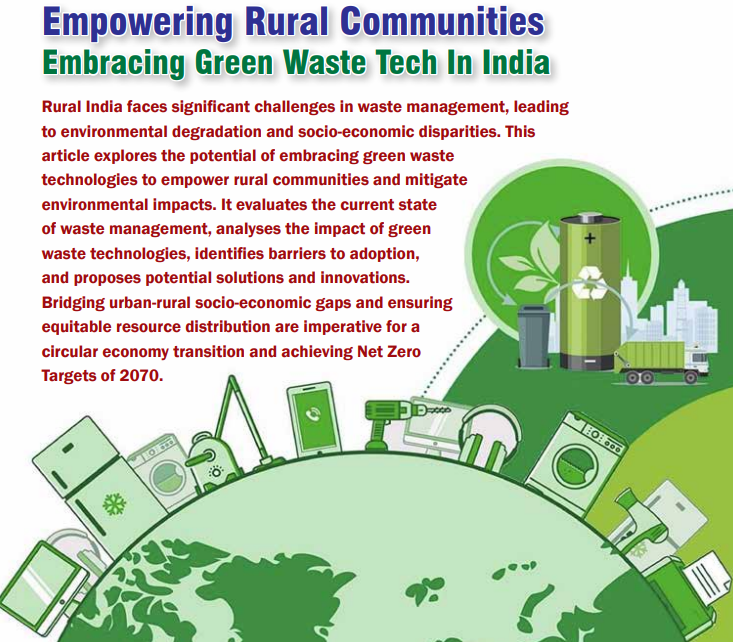
Introduction
- Rural India faces significant challenges in waste management, leading to environmental degradation and socio-economic disparities.
- Embracing green waste technologies offers a potential solution to empower rural communities and mitigate environmental impacts.
- Bridging urban-rural socio-economic gaps and ensuring equitable resource distribution are imperative for a circular economy transition and achieving the Net Zero Targets of 2070.
Current State of Waste Management in Rural Regions
Overview
- Rural waste management in India is underdeveloped, leading to environmental harm.
- Common practices include open dumping, e-waste burning, river dumping, and plastic pollution.
- The lack of formal waste management systems exacerbates the problem.
- Urbanisation and agribusiness sectors threaten organic farming and biodiversity.
- Climate-induced hazards such as floods and droughts, and socio-economic challenges like migration and poverty, complicate the situation.
Types of Waste
- Solid Waste: Includes agricultural residues and wet waste.
- Plastic Waste: Contributes significantly to pollution.
- Biomedical Waste: Poses health risks.
- Construction and Demolition Waste: Adds to environmental burden.
Opportunities
- Implementing green waste practices can transform waste into valuable resources.
- Energy recovery and recycling can generate economic value and reduce environmental impact.
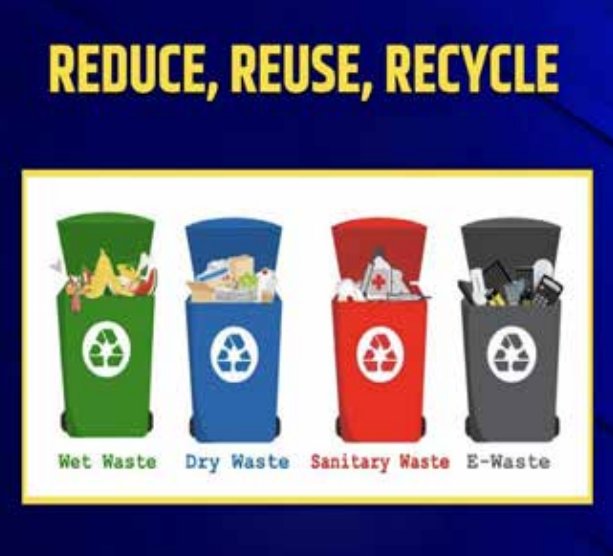
Analysis of the Impact of Green Waste Technologies on Rural Communities
Technologies and Their Benefits
- Renewable Energy: Technologies like Micro-Hydro Power can drive rural development and poverty alleviation.
- Waste Conversion Processes:
- Thermal Conversions: Incineration, pyrolysis, and gasification.
- Bio-Chemical Conversions: Composting and anaerobic digestion.
- Chemical Conversions: Trans-esterification for biodiesel.
Successful Implementations
- Gasification in countries such as Japan, the United States, and European nations reduces waste and greenhouse gas emissions.
- Waste-to-energy solutions decrease reliance on fossil fuels.
Benefits of Implementing Green Waste Technologies
- Empowering Rural Communities: Environmental conservation and socio-economic development.
- Environmental Sustainability: Composting and biogas generation enhance soil fertility and reduce emissions.
- Economic Opportunities: Sale of compost and biogas fosters rural entrepreneurship.
- Climate Resilience: Proper waste management mitigates climate change impacts.
- Community Engagement and Awareness: Knowledge and skills development foster community ownership and responsibility.
Identification of Barriers to Adoption of Green Technologies in Rural Regions
- Pollution: Open burning of agricultural residues, e-waste, and plastics exacerbates air pollution and climate change.
- Infrastructure: Limited infrastructure and resources hinder effective waste management.
- Awareness: Lack of awareness about proper disposal practices leads to harmful consequences.
Potential Solutions and Innovations
Smart Waste Management Systems
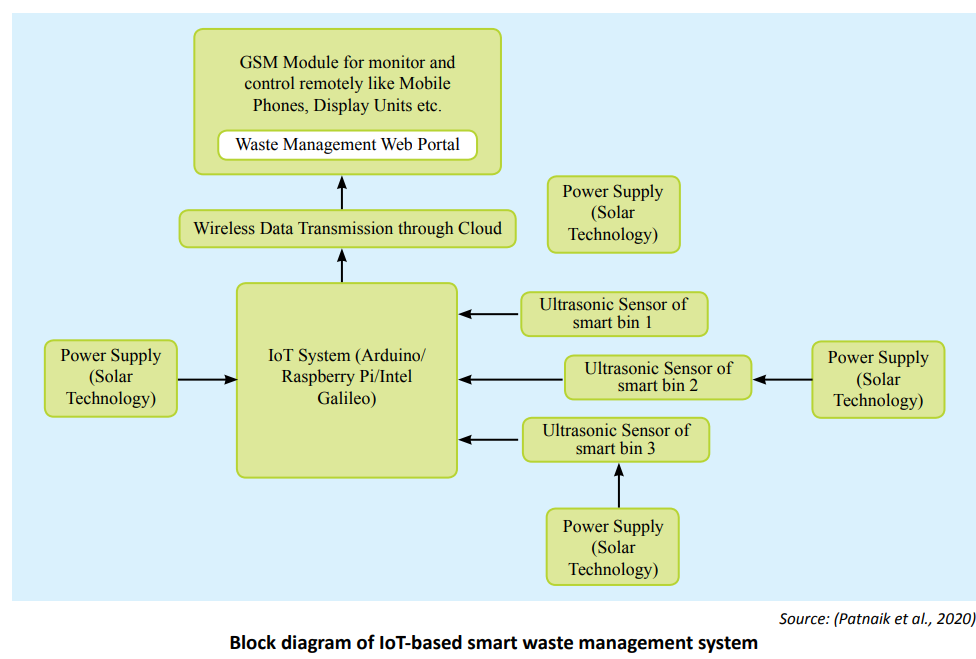
- Internet of Things Integration: Smart bins with ultrasonic sensors collect real-time data.
- Optimized Logistics: GPS-guided trucks enhance collection efficiency.
- Solar-Powered Sensors: Ensure continuous operation.
Best Practices for Successful Implementation
- National Programs: Initiatives like the National Biogas and Manure Management Program and Swachh Bharat Mission.
- Community-Driven Initiatives: Self-help groups promoting composting and organic farming.
Strategies for Overcoming Barriers to Adoption and Scaling up Green Technologies
- Social Inclusion of Waste Pickers: Recognizing their contributions and integrating them into local economies.
- Digital Monitoring: Using Internet of Things, mobile applications, and data analytics to streamline waste collection and disposal.
- Education and Awareness Programs: Enhancing community knowledge on waste management practices.

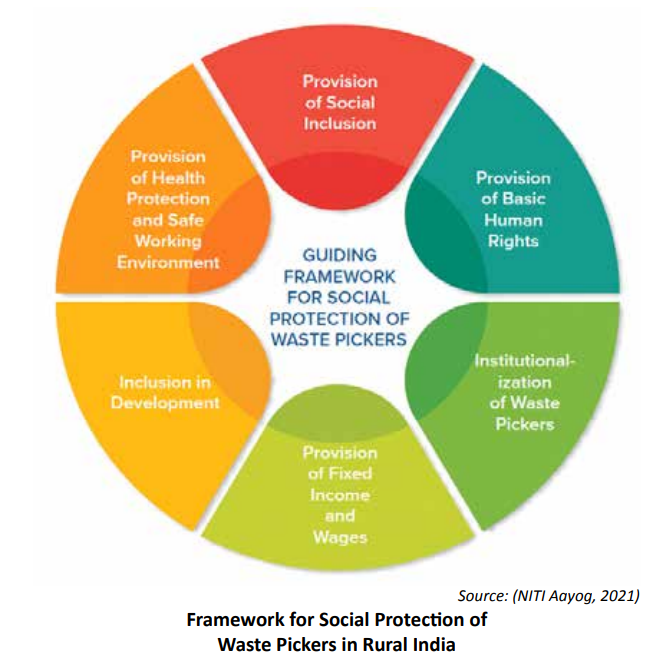
Case Studies
Hasiru Mane Project, Karnataka
- Using geospatial tools for community-led composting and waste management.
Punsari Village, Gujarat
- Generating electricity from village waste, showcasing waste-to-energy initiatives.
Pind Cycle Program, Punjab
- Incentivizing agricultural waste collection for biomass energy production.
Policy Recommendations and Conclusion
Recommendations
- Replication of local best practices in other rural regions.
- Fostering rural entrepreneurship aligned with Sustainable Development Goals.
- Implementing policies to address environmental injustice towards marginalised and remote communities.
- Promoting cohesion policies between urban and peri-urban areas.
- Supporting the concept of sustainable ‘green’ rural municipalities.
Conclusion
- Supportive policy frameworks, financial incentives, and technical assistance are essential for adopting green waste technologies.
- Public-private partnerships can facilitate technology transfer, fostering innovation and entrepreneurship in rural areas.
- By promoting the adoption and scaling up of green waste technologies, India can pave the way towards a greener and more inclusive future for its rural population.
5. Biodiversity Conservation using Remote Sensing and GIS Tools
Introduction
- Biodiversity conservation is a critical challenge globally and in India, one of the twelve mega biodiverse countries.
- Increasing human exploitation and climatic changes threaten biodiversity, necessitating effective conservation strategies.
- Geospatial tools like remote sensing and Geographic Information Systems (GIS) offer significant potential in biodiversity conservation, enabling detailed mapping and analysis even in inaccessible terrains.
Current State of Biodiversity
Global and National Context

- Biodiversity encompasses the variety of life at species, genetic, and ecosystem levels, found in terrestrial, marine, and other ecosystems.
- India, with 2.4% of the world’s land area, hosts over 45,000 plant species and 91,000 animal species.
- India’s biodiversity hotspots include the Himalaya, Indo-Burma, Western Ghats, and Sundaland.
- Biodiversity is spread across ten biogeographic zones, each with unique ecosystems and species.

Pressures on Biodiversity
- Habitat fragmentation and loss pose significant threats.
- Over-exploitation of resources leads to depletion.
- Pollution and invasive species disrupt ecosystems.
- Climate change and global warming exacerbate existing threats.
Significance of Biodiversity Conservation
Ecological Importance
- Biodiversity ensures ecosystem productivity and stability.
- It supports life through ecosystem services like oxygen production, pollination, and water purification.
Economic and Social Value
- Direct utilisation includes timber, food, fuelwood, and fodder.
- Indirect benefits encompass tourism, cultural values, and scientific research.
Global Efforts
- The Convention on Biological Diversity focuses on conservation, sustainable use, and equitable benefit sharing.
- The International Union for Conservation of Nature (IUCN) Red List assesses extinction risk, highlighting species at risk of extinction.
Role of Remote Sensing and GIS in Biodiversity Conservation
Remote Sensing
- Provides data on landscape, regional, and global biodiversity.
- Tracks changes in land use, forest cover, and vegetation.
GIS Tools
- Manages, analyses, and maps spatial data.
- Integrates location data with descriptive information for comprehensive analysis.
Applications in Conservation
- Mapping and monitoring protected areas.
- Analysing habitat fragmentation and land use changes.
- Assessing the impact of climate change on species distribution.
- Facilitating data-driven decision-making for conservation planning.
Issues and Challenges
Technical Barriers
- High cost and complexity of technology.
- Need for specialised training to interpret data accurately.
Implementation Barriers
- Inadequate infrastructure in rural and remote areas.
- Limited access to high-resolution data and satellite imagery.
Policy and Governance
- Need for supportive policies and funding.
- Coordination among various stakeholders for effective implementation.
Potential Solutions and Innovations
Capacity Building
- Training programs for conservationists and local communities.
- Establishing centres of excellence in geospatial technologies.
Policy Support
- Incentivizing the use of remote sensing and GIS in conservation.
- Integrating geospatial tools into national biodiversity strategies.
Technological Advancements
- Developing cost-effective and user-friendly geospatial tools.
- Promoting the use of drones and advanced satellite imaging for real-time monitoring.
Community Involvement
- Engaging local communities in conservation efforts using geospatial tools.
- Creating awareness about the importance of biodiversity and conservation technologies.
Conclusion
- The conservation of biodiversity is crucial for maintaining ecological balance and ensuring sustainable development.
- Remote sensing and GIS tools provide powerful means for mapping, monitoring, and managing biodiversity.
- By addressing technical, implementation, and policy challenges, these tools can significantly enhance conservation efforts.
- Collaborative efforts between government, technology developers, and local communities are essential to harness the full potential of geospatial technologies for biodiversity conservation in India.
6. Usage of Green Technology in Sustainable Water Management
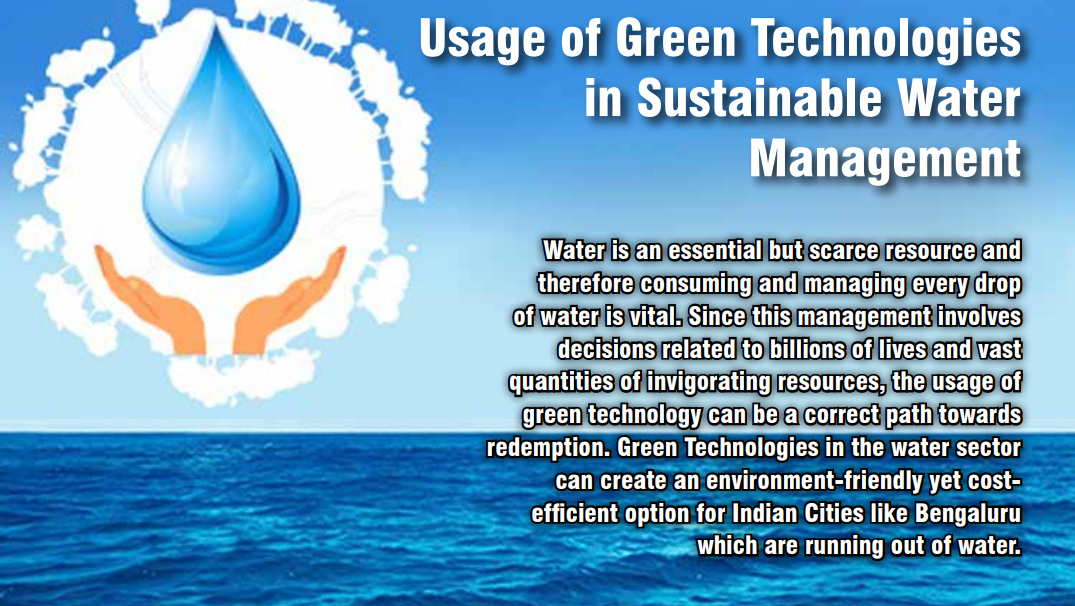
Introduction
- Sustainable water management views the entire water system as an integrated entity, including drinking water, wastewater, rainwater, and stormwater drainage.
- Managing these components together is essential for efficiency and sustainability.
Key Facts
Population Growth
- The increasing population in India has led to a decline in the per capita availability of water.
- Per capita water availability decreased from 1816 cubic meters in 2001 to 1544 cubic meters in 2011.
- It is projected to further decrease to 1140 cubic meters by 2050.
Water Scarcity
- International agencies consider any situation with less than 1000 cubic meters of water per capita as scarcity conditions.
- By 2030, India’s water demand is estimated to be twice the available supply, leading to severe water scarcity for millions of people.
- Water scarcity is expected to result in a 6% loss in the country’s Gross Domestic Product (GDP), according to the National Institution for Transforming India (NITI Aayog).
Green Technologies in the Water Sector
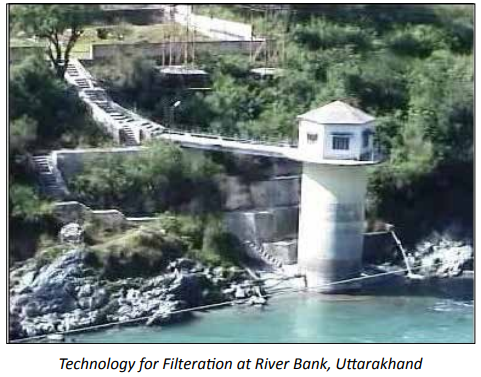
Water Treatment
- Green technologies are used in water treatment processes to purify water for drinking, industrial, and agricultural purposes.
- Advanced treatment methods, such as membrane filtration, ozone treatment, and ultraviolet disinfection, are more energy-efficient and environmentally friendly compared to traditional chemical treatments.
Desalination
- Desalination technologies, such as reverse osmosis and electrodialysis reversal, convert seawater or brackish water into freshwater.
- Green desalination technologies utilize renewable energy sources like solar and wind power to reduce energy consumption and minimize environmental impacts.
Water Conservation
- Green technologies promote water conservation through efficient water use practices.
- Low-flow fixtures, water-efficient appliances, and smart irrigation systems help minimize water wastage and optimize water use in households, industries, and agriculture.
Rainwater Harvesting
- Rainwater harvesting systems capture and store rainwater for various purposes, including irrigation, toilet flushing, and groundwater recharge.
- Green technologies, such as rooftop rainwater harvesting systems and rain gardens, reduce stormwater runoff, replenish groundwater, and conserve freshwater resources.
Greywater Recycling
- Greywater recycling systems collect and treat wastewater from sinks, showers, and laundry for non-potable uses like irrigation and toilet flushing.
- These systems reduce freshwater demand and wastewater discharge, contributing to water conservation and sustainability.
Constructed Wetlands
- Constructed wetlands mimic natural wetland ecosystems to treat wastewater and improve water quality.
- These green infrastructure solutions use vegetation, soil, and microbial processes to remove pollutants and nutrients from wastewater before it is discharged into water bodies.
Smart Water Management
- Smart water management systems integrate sensors, data analytics, and automation to monitor and optimize water distribution, usage, and quality in real-time.
- These systems improve operational efficiency, reduce water losses, and enable proactive water resource management.
Other Methods to Filter Wastewater
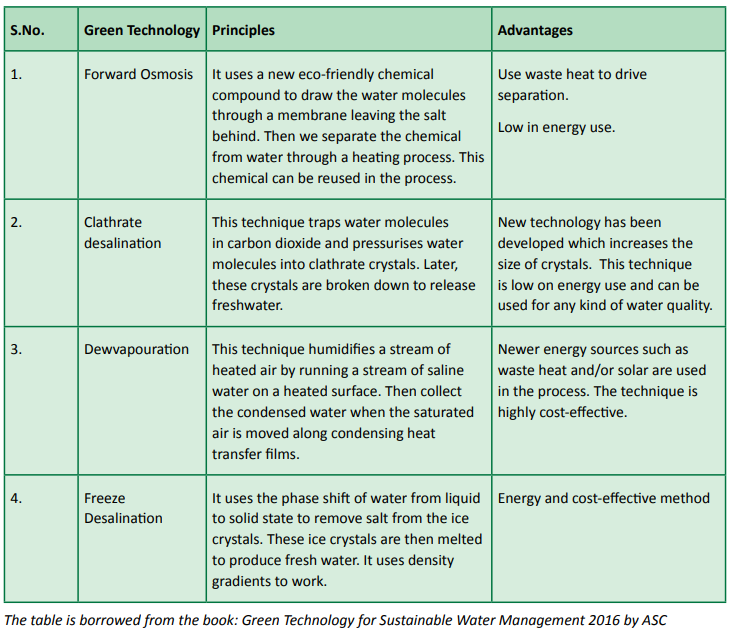
Forward Osmosis
- This technology uses a new eco-friendly chemical compound to draw water molecules through a membrane, leaving salt behind.
- The chemical is then separated from the water through a heating process and can be reused.
- Forward osmosis is low in energy use and utilizes waste heat to drive separation.
Clathrate Desalination
- This technique traps water molecules in carbon dioxide and pressurizes them into clathrate crystals.
- The crystals are later broken down to release freshwater.
- Clathrate desalination is low in energy use, can handle various water qualities, and employs newer energy sources like waste heat or solar power, making it highly cost-effective.
Dewvapouration
- Dewvapouration humidifies a stream of heated air by running a stream of saline water on a heated surface.
- The condensed water is collected when the saturated air is moved along condensing heat transfer films.
- This technique uses newer energy sources such as waste heat and solar power, making it cost-effective.
Freeze Desalination
- This method uses the phase shift of water from liquid to solid state to remove salt from the ice crystals.
- The ice crystals are then melted to produce freshwater.
- Freeze desalination is energy and cost-effective.
Biofilters
- Microorganisms or bacteria grow on biofilters to form a biofilm.
- Wastewater passes through this biofilm, accelerating the degradation of pollutants and organic matter.
Bioremediation
- Microorganisms are applied to wastewater sites to remove hazardous species or convert toxins into less or non-toxic materials.
- Bioremediation is a cost-effective method that does not require excavation or incineration.
Electrowinning
- This process involves passing current through wastewater using electrodes.
- Metals are electro-extracted from their oxidized forms and deposited on the cathode.
- Heavy metals like copper, nickel, silver, gold, and cadmium can be recovered from wastewater through electrowinning.
Conclusion
- The integrated management of drinking water, wastewater, rainwater, and stormwater drainage is essential for sustainable water management.
- The decline in per capita water availability in India and the projected increase in water demand necessitate the adoption of green technologies in the water sector.
- Green technologies in water treatment, desalination, water conservation, rainwater harvesting, greywater recycling, and constructed wetlands offer environmentally friendly and cost-effective solutions.
- Smart water management systems and innovative wastewater filtration methods, such as forward osmosis, clathrate desalination, and bioremediation, enhance water sustainability.
- Addressing water scarcity through sustainable practices and technologies is crucial for environmental preservation and economic stability.
7. Green Technologies for Sustainable Agriculture
Introduction
- Green technology in agriculture plays a crucial role in fostering sustainable practices aimed at enhancing productivity, maintaining soil fertility, and reducing environmental impact.
- These innovations are pivotal in addressing global challenges such as climate change and resource scarcity, while promoting eco-friendly techniques for food production.
Green Technologies Adopted in Agriculture
- Organic Farming
- Techniques: Organic farming utilizes methods like crop rotation, green manure, composting, and biological pest control to enhance soil health and fertility.
- Weed and Soil Management: It emphasizes weed control without pesticides and manages soil health through natural means.
- Resource Utilization: Organic farming uses animal manure and green manure crops to maintain soil fertility naturally.
- Environmental and Health Benefits: This approach minimizes environmental impact, reduces chemical residues in food, and promotes healthier ecosystems and human health.

- Agroforestry
- Integration of Trees with Crops/Livestock: Agroforestry involves integrating trees with crops or livestock on the same land, fostering ecological and economic interactions.
- Diversification and Sustainability: It diversifies agricultural production, enhances soil fertility, and provides additional income streams for farmers.
- Environmental Sustainability: Agroforestry promotes sustainable land use by improving soil structure, biodiversity, and carbon sequestration.
- Integrated Pest Management (IPM)
- Sustainable Pest Control: IPM integrates natural pest control methods with minimal use of chemical pesticides.
- Ecosystem Preservation: It aims to minimize disruption to ecosystems while effectively managing pest populations through biological controls and cultural practices.
- Versatility and Challenges: IPM is applicable in various agricultural settings but requires expertise and resources for successful implementation.
- Biogas
- Renewable Energy from Agricultural Waste: Biogas technology converts agricultural waste into renewable energy (biogas) and organic fertilizers through anaerobic digestion.
- Benefits: It reduces dependence on non-renewable energy sources, improves soil fertility with organic by-products, and mitigates greenhouse gas emissions from agricultural waste.
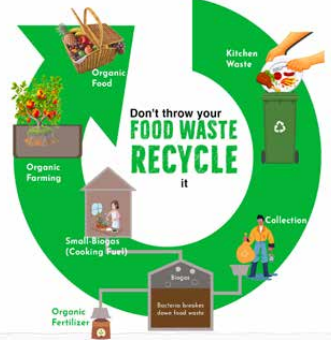
- Mixed Farming
- Diversified Agricultural Practices: Mixed farming integrates different crops and/or livestock on the same farm, optimizing land use and enhancing farm resilience.
- Benefits: It improves soil fertility, reduces pest and disease risks, and provides economic stability through diverse income sources.
- Crop Rotation
- Enhancing Soil Health: Crop rotation involves alternating crops in sequence to improve soil structure, nutrient availability, and pest management.
- Sustainability Benefits: It reduces reliance on synthetic fertilizers, mitigates soil erosion, and supports sustainable farming practices.
- Drones and Digital Sensors
- Precision Agriculture Tools: Drones and digital sensors enable farmers to monitor crops remotely, gather real-time data on soil conditions, crop health, and microclimates.
- Environmental Impact: These technologies optimize resource use, minimize environmental impact through targeted applications of inputs, and enhance overall farm efficiency.
Advantages of Green Technology in Agriculture
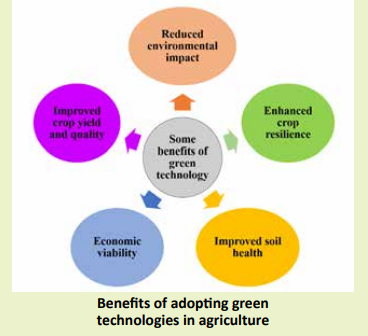
- Sustainability: Green technologies promote sustainable agricultural practices by reducing environmental footprint, conserving resources, and enhancing ecosystem health.
- Productivity: They improve crop yields, optimize resource use efficiency, and enhance farm profitability.
- Environmental Stewardship: Green technologies mitigate climate change impacts, reduce pollution, and preserve biodiversity.
- Health Benefits: Organic farming and reduced chemical use contribute to safer food products and healthier ecosystems.
Challenges for the Adoption of Green Technologies by Farmers
- Cost: High initial investments and ongoing operational expenses can be prohibitive for farmers, particularly in developing regions.
- Knowledge and Skills: Lack of technical expertise and training in green technologies may hinder adoption and effective implementation.
- Infrastructure and Accessibility: Limited access to green technology infrastructure, such as renewable energy systems and precision agriculture tools, poses challenges.
- Policy Support: Inconsistent policies and regulatory frameworks may not adequately support the adoption and scaling of green technologies in agriculture.
Future of Green Technologies in Agriculture
- Technological Advancements: Continued innovation in precision agriculture, biotechnology, and renewable energy integration will drive the future of green technologies.
- Global Demand: Growing global demand for sustainable food production practices will incentivize the adoption of green technologies.
- Collaboration and Education: Partnerships between stakeholders, policymakers, and research institutions are crucial to developing accessible and effective green technology solutions.
- Environmental Resilience: Green technologies will play a pivotal role in building resilience to climate change impacts and ensuring food security in the face of global challenges.
Conclusion
- Green technologies are pivotal in transforming agriculture towards sustainability, balancing productivity with environmental stewardship.
- The adoption of these technologies offers solutions to mitigate climate change impacts, enhance resource efficiency, and promote healthier ecosystems.
- Collaborative efforts and supportive policies are essential to overcoming challenges and realising the full potential of green technologies in agriculture.


